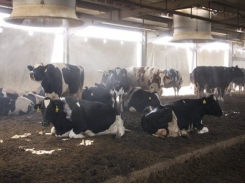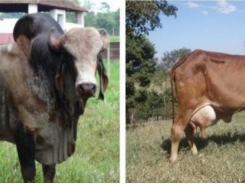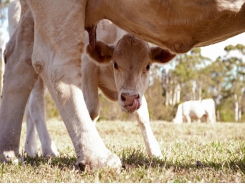Transponders monitor cow activity to support lameness management

Lameness has an impact on milk production, welfare and herd profitability. It is a serious problem in many dairy herds worldwide. One of the major causes of feet problems is a lack of lying time for the cows. A new monitoring system provides insight, enabling specific adjustments in the cows environment to improve lying time and subsequently hoof health.
Lameness is being poorly monitored on many farms in comparison to mastitis and fertility. "That is a problem," says Dr Jan Lievaart of the Dutch Hoof Health Centre. "Many dairy cows do not lie down enough to meet their natural needs." Although cows should lie down for 12 to 14 hours per day to meet their needs, there is a wide variation between farms but also between cows within the same herd. Some only lie down for eight hours even if the herd average is 12 hours. Too little time lying down can result in sole bleeding and ulcers due to too much pressure on the hooves. If cows stand on a wet surface there is also an increased risk for digital dermatitis. In Europe 11% and the US 15% of cullings are due to hoof problems. Data from the US suggests, indirectly, that this may even be as high as 49%.
Cow positioning system
In the Netherlands, according to the records of the Dutch hoof trimmers, in 2013 the numbers of affected cows varied between 27% for sole bleeding and 18% for digital dermatitis. However, these numbers are not accurate as many cows can have multiple problems. It also doesn't mean all these cows are lame; in fact the current estimated average lameness data varies between 20 to 25% per year. "As there are not very many systems on the market to monitor lying time, the majority of farmers use very global estimates to indicate the lying behaviour of their cattle," acknowledged Lievaart. He introduced the Cow Positioning System (CPS), a monitoring system with a transponder band that provides insight in lying time, this enables farmers to change management tactics and the environment if needed to improve laying time and indirectly hoof health. According to him, the lack of recording of lameness causes and proper systems to measure risk factors, such as lying time, may partially explain why lameness control lags behind other endemic diseases. Access to good-quality data is a vital first step in controlling lameness.
Although a transponder band around a cow's leg is commonly used as a heat detection tool, the CPS works differently. This system is originally used in the water sector, where it measures the x/y/z-axis of water currents. The cubic shaped monitoring device is attached to a cow's ankles and measures an angle of 0 or 180 degrees. Then via a software programme it can calculate how much and how many times per day cow lies down. The transponder was placed on the ankles of ten randomly select cows from a cross-section of the farm, in order to prevent a distorted picture through a biased selection of only fresh cows or heifers. It measured the standing and lying behaviour of the cows each minute for a week. Then the software programme calculated how much and how many times that cow lay down per day. The more time they spend standing, the more damaging it was for their hoofs. The monitoring results showed some cows only lay down for 6 to 7 hours per day. The data collected so far show significant differences of close to 50% between and within herds.
Link between lying time and lameness
Overcrowding, low ranking order in the herd, poor designed and maintained cubicles can all contribute to a suboptimal laying time. The monitoring system also showed that cows that lie down less often stay down relatively longer once they do. Although veterinarians prefer that cows complete the circle of eating, drinking, lying down ten times a day, and cows normally get up every one and a half hour, the animals that laid less frequently often stayed down for several hours.
The measured data not only provides insight in the lying behaviour of cows, but also offers the farmer the possibility to make targeted adjustments to the environment and management, to improve hoof health. Research by Nigel Cook of the University of Wisconsin showed a clear link between the number of hours that cows stand and the number of lame animals. If the measurements of the monitoring system show insufficient lying time, further research is needed to find the underlying causes. The stall dimensions partly determine the amount of time a cow spends lying down daily. Incorrect stall dimensions, size or bedding often play a role. Further factors include the floor being uneven or hard and whether it is fitted with a rubber mat. If it takes a cow a long time to lie down, either the stall size or bedding it not right. Standard sizes do not apply. But in some cases it is not the environment but the management, such as waiting times before milking. Some farms have a mismatch between the number of cows being milking and the size of the milking parlour. Creating a customised solution for each company makes more sense.
Early results promising
Until now, the new monitoring system has only been used on Dutch soil and has been operational too short to be able to share results of the effect of adjustments based on the system. "With regard to hoof health, results only become clear after six months to a year," says Lievaart. But already farmers have made adjustments based on the recordings of the standing and lying time on their farm. Lievaart expects, however, that hoof health and the need for monitoring systems will become increasingly important worldwide. "Western consumers increasingly feel that animal welfare is very important. And if you talk about animal welfare in the case of cows, this immediately includes hoof health."
Welfare may not play a major role in certain countries, but the strong economic interests of the farmer are of limitless relevance. Hoof health costs an average of €50 per cow. This may amount to €300 to €400 and thus comprises the highest costs after fertility and mastitis. Lievaart predicts: "Between now and five years from now, all we will be talking about is hoof health."
Related news
Tools

Phối trộn thức ăn chăn nuôi

Pha dung dịch thủy canh

Định mức cho tôm ăn

Phối trộn phân bón NPK

Xác định tỷ lệ tôm sống

Chuyển đổi đơn vị phân bón

Xác định công suất sục khí

Chuyển đổi đơn vị tôm

Tính diện tích nhà kính

Tính thể tích ao




 Optimal ruminant performance during exposure to mycotoxins
Optimal ruminant performance during exposure to mycotoxins  Cow's high selenium diets may boost protein transfer…
Cow's high selenium diets may boost protein transfer…